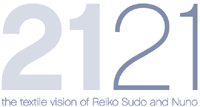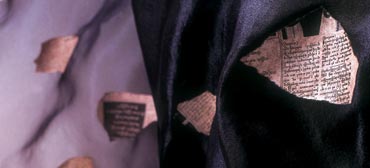
|
education
programme : AMBIGUOUS SPACES :
Matilda McQuaid Nuno textiles are at the forefront of contemporary textile design. They represent a convergence of centuries-old traditions with advanced technologies ultimately transforming how we think about textiles today. As the creative director of Nuno, Reiko Sudo has lead her team of designers to be inspired by encounters with the everyday world so that feathers, nails, paper and copper become key components in their textile making. The recent 'Extreme Textiles' exhibition at the Cooper-Hewitt revealed the importance of collaboration between hand craftsmanship and technology. This lecture will discuss the creative process at Nuno and how the discovery of materials and technologies in other contexts, can lead to some of the most innovative and beautiful textiles produced today. Bradley Quinn Although the relationship between textiles and architecture was recognized more than a century ago, few studios are committed to exploring the interfaces and innovations that the axis between these two disciplines can yield. One of the leading pioneers in this field today is Reiko Sudo, who has consistently blurred the boundaries between body, space, materials and materiality in the textiles produced by NUNO. As the pliable metals, sustainable materials, lightweight glasses and malleable plastics used in building construction found expression in NUNO’s forward-thinking fabrics, a new paradigm of architectonics was born. From the 1980s onwards, NUNO incorporated architectural principles into tactile fabrics by reinterpreting textile construction as an expression of volume, voids and three-dimensional structures. Throughout the 1990s, NUNO’s use of metals, glass and other heavyweight materials corresponded to the devices of transparency, density and egress deployed by architects, meaning that concerns such as corrosion, moisture, metal fatigue and urban air quality became central concerns for modern-day textiles. As the twenty-first century dawned, NUNO moved forward with an ‘Eco’ collection that explored biodegradable maize fibre and other eco-synthetics; likewise, leading architects also made issued of environmental sustainability central to their work. Sustainability was nothing new to Reiko Sudo, however, whose fabric collection includes Bashofu, a textile based on Okinawan banana fibre weaving. NUNO’s impact on textile developments has resulted in fabrics that could potentially enable clothing to act as individual climate-controlled environments, perhaps even wearable ‘dwellings’ that act as both shelter and clothing. At a time when architects are developing textile structures and borrow techniques such as pleating, stapling, cutting and draping from traditional tailoring, the architectonic properties of NUNO’s textiles could reveal new interfaces between our bodies and the spaces we dwell in. Bradley Quinn’s talk is the first attempt to investigate the relationship between NUNO’s textiles and contemporary architecture in considerable depth, by examining the impact of the ideas, techniques and materials pioneered by Reiko Sudo on new perceptions of urban space. Dr Bojana Pejic Dr Pejic speaks on ‘Women at Work’ - a performance series realized by Maja Bajevic, an artist from Sarajevo, who is currently based in Paris. In these collaborative works, subtitled ‘Under Construction’ (Sarajevo, 1999), ‘The Observers’ (France, 2000), and ‘Washing Up’ (Istanbul Biennial, 2001), Bajevic performs together with Muslim women who earlier lived in the region of Srebrenica. After the massacre in Srebrenica where between 11 and 12 July 1995 Serbian armies murdered around 8.000 Muslim men, these women live in Sarajevo as refugees. In her solo pieces and those produced in cooperation with other women, the artist delicately interlaces her inimitable politics of domesticity: politics made manifest through the public performing of diverse manual activities, like embroidering, sewing or laundering. These habitual female proceedings, repetitive and monotonous, are carried out in public spaces (on a façade or in a public bath) so as to lay bare customary women's activities for coping with absences. Julia Griffiths Jones Julia Griffiths Jones presentation will include drawings of costume, as well as photographs taken on her research trips. It will describe the methods she uses to transfer her drawings into metalwork, paying particular reference to her current U.K. touring exhibition-‘Stories in the Making’. Sophie Roet In March 2005, the 'Sophie Roet for RB textile collection' was launched in Paris. This is a collection of extremely refined and delicately woven, embroidered and printed textiles which have been produced in Kolkata. Sophie's signature is of simplicity and pure design - ironically, she uses traditional Indian textile techniques to create contemporary textiles. Her aim for creating this collection was to go back to the roots of craftsmanship and celebrate the importance of handmade textiles for the luxury end of the fashion world. "Beautiful craftsmanship is becoming rare and precious - it takes time and irregularities occur. I want to celebrate these irregularities and the soul of the fabrics which are produced and embellished by hand." Catherine Bertola Bertola will present a brief introduction to her practice, to provide an insight into her research process and approach to making. Using examples of past works she will illustrate the development and context of her work, before talking in more detail about her current project for the exhibition at Fabrica and Nottingham Castle Museum and Gallery. Following a period of research Bertola will be producing a number of works based on ‘prickings’, the vellum templates used in lace making, to create a series of objects and drawings that relate to the historical costumes and garb worn by aristocratic women. The ‘prickings’ are in effect the skeleton of the lace, and represent the point at which the lace changes from the hands of the maker to the collar of the wearer, representing two very different polar and opposite roles and images of women in history. Philip Delamore Philip Delamore comes from a printed textile background and has worked on digitally printed textiles for fashion. Currently a Research Fellow at the London College of Fashion, he will be speaking about his work on CAD prototyping. This explores the potential for digitally generated designs for textiles. Whilst interested in the process and engineering aspects of CAD, Philip’s approach remains primarily textile based His research has included experimenting with revolving fabric and cutting out form. He has recently been working with body scans as a starting point for textile designs. |
Participants: Keynote speaker Other Speakers Dr. Bojana Pejic, Curator Catherine Bertola, Artist Sophie Roet Textile, practitioner Julia Griffiths Jones, Textile artist Philip Delamore, Research Fellow, London College of Fashion Chair
|


